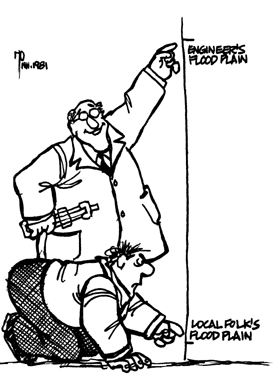
Number 1, July 1999
This is the first in a new, peer-reviewed series that summarizes current knowledge about various aspects of natural hazards for practitioners, researchers, public policy makers, and others. It is distributed free to all subscribers of the Natural Hazards Observer.
What This Informer Does
This issue of the Informer describes a process for developing a community flood hazard mitigation plan, especially one that will be recognized by the National Flood Insurance Program's Community Rating System (CRS). It provides a step-by-step process to develop a plan and offers tips and guidelines for making the process successful. Persons interested in obtaining more detailed information on hazard mitigation planning, floodplain management, and the Community Rating System are encouraged to explore the bibliography and recommended reading at the end of this paper. Although the focus of this issue is floods, the process can also be used in mitigation planning for other hazards.
Who Should Read This and Why
This issue should be read by anyone involved in a community flood mitigation program, especially city and county planners, because it provides valuable advice on how a community can reduce its vulnerability to floods while also meeting other community goals such as economic vitality and environmental quality. Further, this Informer outlines a process that is easily adaptable to a variety of hazards and hazard programs. Finally, anyone interested in the problems faced in developing a community plan of any sort may benefit from this view of the real world of mitigation planning.

by French Wetmore and Gil Jamieson
So, your community has a flood problem . . .
Your residents and elected officials probably want to see it solved as quickly as possible, maybe even want a flood control project that will keep the problem away forever. However, such a response to flooding has many shortcomings, most notably expense, environmental disruption, and future watershed development that can make a project obsolete.
You probably also know that there are many alternatives to building a flood control project, ranging from managing development in floodplains and their watersheds, to acquiring or floodproofing buildings and infrastructure, to educating citizens about how to protect themselves and their property from floods.
There is no shortage of possibilities for dealing with a flood problem. The key is to select options that are appropriate for the local situation--in other words, mitigation planning, a systematic, objective review of the flood problem and what can be done about it.
In order to convince the public and decision makers that mitigation planning is the way to go, tell them:
These advantages should provide adequate reason for your community to undertake a flood mitigation plan. However, planning is often not initiated on the basis of its merits. So, here's another reason: it can help you get money. Several federal funding programs require or strongly recommend a plan as a prerequisite for assistance, including the Federal Emergency Management Agency's (FEMA's) Flood Mitigation Assistance and Hazard Mitigation Grant Programs and several flood control programs of the U.S. Army Corps of Engineers.
Planning is also encouraged by FEMA's Community Rating System (CRS). Under the CRS, flood insurance premiums are reduced based on a community's floodplain management activities. The CRS can get residents' attention because they see a direct financial benefit--lower flood insurance premiums. (And, once you have residents' attention, you have the attention of elected officials.)

Conflicts in Flood Management |
| Have you seen these situations? Mitigation planning can resolve conflicts that often exist between flood protection and other community goals and activities. |
|
Not only are the CRS floodplain management activities more effective when undertaken pursuant to a mitigation plan, the CRS provides additional credit to a community that implements one. That is, the CRS provides credit points for a plan that has been prepared, adopted, and implemented in accordance with its criteria, and these criteria provide excellent guidance on preparation of a community flood mitigation plan. In fact, plans that meet the latest CRS criteria meet the planning prerequisite of the FEMA and Corps programs noted above.

These criteria are found in the CRS Coordinator's Manual under Activity 510 (Floodplain Management Planning). More details and three model plans are found in the CRS publication, Example Plans. Both are available for free by calling (317) 848-2898. (If you're just interested in mitigation planning, you only need Example Plans, which has everything in the Manual and more).
This issue of The Informer reviews the CRS planning criteria and offers some suggestions for implementing a plan locally. It is based on the authors' 40 years of combined experience in flood mitigation planning and the lessons learned by others who have helped refine the CRS criteria into a proven approach.
The Planning Process
Keep in mind that your objective is not to crunch out a fancy document; what really counts is how you prepare your plan. It is not the resulting publication, but rather the process of planning that is important, including reviewing activities, educating residents, obtaining consensus, building constituencies, and all the other great things mentioned earlier.
There are 10 steps to the CRS planning process. Actually, there's nothing unique about it, since planners will recognize the classic planning approach of gathering information, setting goals, reviewing alternatives, and deciding what to do. The steps are:
1) Organize to prepare the plan.
2) Involve the public.
3) Coordinate with other agencies.
4) Assess the hazard.
5) Evaluate the problem.
6) Set goals.
7) Review possible strategies and measures.
8) Draft an action plan.
9) Adopt the plan.
10) Implement, evaluate, and revise the
plan.
We will look at these 10 steps in a little more detail. However, note that many states and regional agencies have developed their own, often more locally appropriate, planning procedures. In some cases, certain steps must be followed to comply with state law. Check with your state planning agency, National Flood Insurance Program (NFIP) coordinator, or emergency management agency's hazard mitigation officer for information on requirements, guidance, and assistance.
Also consider whether mitigation planning should be incorporated into your community's comprehensive planning process. On one hand, if it is not part of a comprehensive plan, you may be able to avoid some constraints and formalities (such as the legal process required for public hearings). On the other, you may want to trade flexibility and informality for the status and legal authority your mitigation plan will have if it is part of a comprehensive plan.
In either case, your flood planning needs to be coordinated with other planning efforts. But, be aware that a floodplain management plan or mitigation plan involves many more activities than a land-use plan. Determining the best land-use and construction standards for flood-prone areas needs to be a part of the process, but so do warning activities, public information, and a whole host of other efforts that can lessen flood impacts.
One final introductory note: this is a basic planning process. The 10 steps work, as witnessed by communities that have followed them and are reducing flood losses. However, an experienced planner or an office with a large staff can and should improve on this basic approach. More data, more sophisticated materials, and a more formal decision-making process can be helpful, especially in larger communities.



The planning process will succeed only if the right people and agencies are involved.
The planner: Selecting the person in charge of the planning process is the crucial first step. We assume that person is you, the reader. You may be a professional planner or you may be an emergency manager, a council member, or the chair of the citizens' planning committee. Whatever your background, be sure to check on the state requirements for planning and coordinating with other planning efforts.
It helps if you are officially designated with the authority to develop the plan. A council resolution or a memo from the city manager or mayor is useful, because one of your biggest challenges will be getting other departments to devote some attention to your task.
It also helps (in fact, it's vital) to have an open mind about the variety of potential mitigation measures. Different professionals will bring their own preferences to the process. For example, a mitigation plan designed by an engineer often favors structural measures, while a plan prepared by an emergency manager may be biased toward flood warning and response activities.
Staff support: Your first job is to line up staff responsible for implementing the plan. They need to be involved in the planning process for three reasons:
Who Can Help? |
| There are many offices that should be involved in mitigation planning, including: |
|

These people have their own concerns, and hazard mitigation is probably not one of them. Do not view them as trouble makers or dead weight, but as people who can help you design and support an effective program. There are some real advantages to involving them:
The last item can be doubly rewarding. Floodplain residents can provide some of the data you will need, such as historical high water marks and flood damage information. Also, involving the public in this effort involves them in the whole process and helps them to become invested in the outcome, something that will pay off when it is time to submit the plan for adoption and implementation.
There are a variety of ways to involve the public. Members of the public can
A Planning Success Story |
| Following a flood in 1990, Village officials of South Holland, Illinois,
were faced with many angry residents who were convinced that the
Village was not doing enough to protect them. The Village formed a
Flood Liaison Committee so residents and staff would work together.
The Committee spent a year preparing a floodplain management plan that reviewed all the alternatives and recommended 31 action items. The Village began providing technical assistance and a floodproofing rebate program that has helped fund over 300 self-help protection projects. Residents are now active participants in the Village's mitigation program. South Holland has since received one of the highest ratings in the Community Rating System (Class 6), has received state and national awards, and has played a lead role in the initiation of a watershed-wide flood and stormwater mitigation planning effort. |

Planning committee: Creating a planning committee is a simple and proven way to involve both staff and the public. We strongly recommend a committee of 10 to 15 people, representing local government staff and the public, to bring key stakeholders together. A committee can be a forum to review the needs and concerns of all interested groups, and a means for participants to keep their departments and the community up to date on the plan's progress.
The importance of this approach is reflected in the credit points awarded by the CRS program. Having a planning committee with at least half of the members from the public is worth more points than any other single item in this CRS activity.

 There are two reasons to involve government agencies and private organizations in your planning effort. First, they may be
implementing or planning to implement activities that can affect flooding or other concerns. As mentioned earlier, it is
important to keep mitigation planning efforts from conflicting with an existing government program or duplicating the
efforts of another organization.
There are two reasons to involve government agencies and private organizations in your planning effort. First, they may be
implementing or planning to implement activities that can affect flooding or other concerns. As mentioned earlier, it is
important to keep mitigation planning efforts from conflicting with an existing government program or duplicating the
efforts of another organization.
The second reason is to obtain help, which may be in the form of flood data, technical information on various measures, guidance on regulatory requirements, advice and assistance in the planning effort, implementation of a recommended measure, or financial assistance to help implement a recommended measure.
Agencies to contact include:
Also coordinate with the following organizations, which either conduct flood mitigation programs or represent the various publics you want to involve:
The public representatives on your planning committee can help identify appropriate organizations. The list can be long. At a minimum, contact these groups and tell them the planning schedule; they may want to participate somewhere along the line.
Many activities, such as maintaining a stream that forms a common boundary, should also be coordinated with neighboring communities. Also, many activities, such as flood warning and stormwater management, can be more effective or less expensive when done on a regional or watershed basis.
 Informer
index
Informer
index